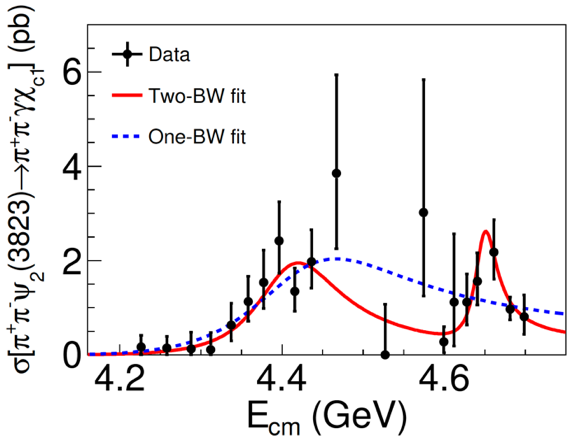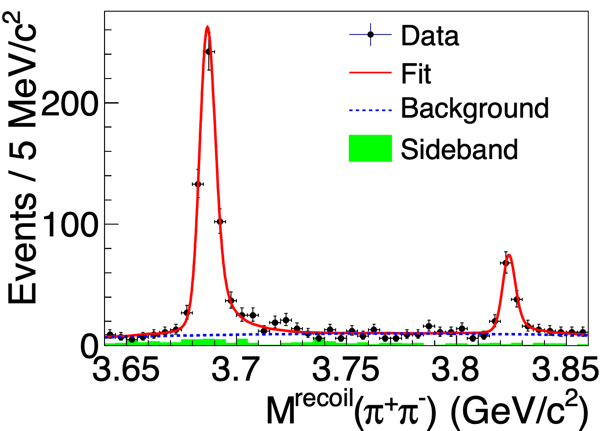

The BESIII experiment recently reported an observation of resonance structures in the e+ e-→π+ π- ψ2(3823) process, and also achieved the most precise mass measurement of theψ2(3823) state. These results have been published in Physical Review Letters [Phys. Rev. Lett. 129, 102003 (2022)].
In 1964, both Gell-Mann and Zweig proposed the famous Quark Model. It tells us hadrons are composite particles and fall into two classes: baryons, composed of three quarks, and mesons, bound states of a quark–antiquark pair. In the past decades, the Quark Model is successful in describing most hadrons observed in experiment. However, in recent years there are many new particles discovered in the charmonium energy region. These particles, usually referred as XYZ particles, are good candidates for “exotic” hadron states, whose quark contents are different from conventional baryons/mesons and allowed by the QCD theory, such as multi-quark states, molecules, hybrids etc. The study of exotic hadrons is an interesting topic in the field of particle physics.
The vector Y-states are produced in e+e- annihilation, and usually discovered in the decay to hidden charm final state, such asJ/ψ ,ψ(2S). In this study, for the first time the BESIII Collaboration uses the D-wave ψ2(3823) charmonium state as a new probe to search for vector Y-states. The D-wave related data is rare in experiment and the study is challenging due to low production cross section. By developing a new partial reconstruction method, the signal efficiency is improved by a factor of two. With a data sample corresponding to an integrated luminosity of 11.3fb-1 collected at center-of-mass energies from 4.23 to 4.70 GeV, BESIII measures the energy dependent cross section of the e+ e-→π+ π- ψ2(3823) times the branching fraction B[ψ2(3823)→γχc1]. Resonance structures are observed in the cross section line shape with a statistical significance larger than 5σ. This is the first observation of vector Y-states coupling to D-wave charmonium state.
At the moment, due to lack of data around 4.5 GeV, whether the resonance structure comes from one single resonance or the Y(4360)/Y(4660) resonances is still not clear. If the single resonance interpretation is true, a new vector Y-state is observed; on the other hand, if the Y(4360)/Y(4660) interpretation is correct, it will shed light on the nature of the Y(4660) resonance, such as an f0ψ(2S) hadronic molecule, a Σc0`Σc0 baryonium, or an excitation of the ψ(4260).
In addition, the BESIII experiment also precisely study the properties of the ψ2(3823) charmonium state. By using the ψ(2S) as a reference, BESIII measures the mass of ψ2(3823) to be (3823.12±0.43±0.13)MeV/c2). This is the most precise mass measurement of ψ2(3823) to date, which has a better precision than LHCb. The precise mass of ψ2(3823) can be used to calibrate the parameters in the potential model, and greatly deepens our understanding of the dynamics in the c`c system.


The Phys. Rev. Lett. Publication link:
https://journals.aps.org/prl/abstract/10.1103/PhysRevLett.129.102003